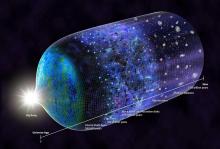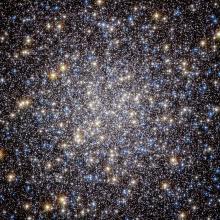Listen to today's episode of StarDate on the web the same day it airs in high-quality streaming audio without any extra ads or announcements. Choose a $8 one-month pass, or listen every day for a year for just $30.
You are here
GN-z11
Studying one of the farthest known galaxies is like taking a trip through time. Its light has taken 13.4 billion years to reach us. So we see it as it looked when the universe was just 400 million years old.
GN-z11 was discovered five years ago. Astronomers determined its distance by measuring a shift in the wavelength of its light. The shift is caused by the expansion of the universe itself, which causes galaxies to move farther apart.
We’ve learned that the galaxy was small but busy. It was giving birth to new stars at a furious rate, mainly because it still had huge amounts of hydrogen and helium — the raw materials for making stars.
Despite its youth, some of its stars had already expired. As they died, they peppered the galaxy with heavier elements created by the stars themselves. That means the light we see from GN-z11 comes from second-generation stars — those that incorporated elements produced by the first generation. So astronomers continue to look for galaxies that are even farther — populated by the very first stars.
Since we see GN-z11 as it looked early on, we have no idea what it looks like today — and we never will. Because of the continued expansion of the universe, it’s moving away from us so fast that the light it shines into space today can’t travel fast enough to reach Earth. So sometime in the future, GN-z11 will simply fade from sight — lost forever in the distant universe.
Script by Damond Benningfield






